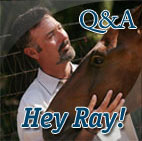Identifying your horse
 We all love our horses. We invest time and money into their care and upkeep. I think it is natural for us to want to protect the emotional and financial investment we have in our horses. This month I am going to discuss the various forms of identifying our horses.
We all love our horses. We invest time and money into their care and upkeep. I think it is natural for us to want to protect the emotional and financial investment we have in our horses. This month I am going to discuss the various forms of identifying our horses.
Registration Paperwork
Each breed registry has its own method for identifying the animal for which they produce papers for. Pictures, written descriptions, and drawings are found on these different documents. They usually also include the parentage of the registered horse.
Your horse’s eye health
 The eyes are extremely important to our equine companions. If we lose one or both eyes, it can be career-ending for our animals. Signs of eye discomfort are blepharospasm (squinting), tearing of the eye, rubbing of the eyes, and changes in the normal appearance of the eyes. This month I will discuss some of the more common eye ailments I see and some tips on what can be done. Before we proceed, I feel I should mention that most eye problems should be seen sooner rather than later. Waiting can be devastating on some of these problems.
The eyes are extremely important to our equine companions. If we lose one or both eyes, it can be career-ending for our animals. Signs of eye discomfort are blepharospasm (squinting), tearing of the eye, rubbing of the eyes, and changes in the normal appearance of the eyes. This month I will discuss some of the more common eye ailments I see and some tips on what can be done. Before we proceed, I feel I should mention that most eye problems should be seen sooner rather than later. Waiting can be devastating on some of these problems.
Eyelid Lacerations
Eyelid lacerations are extremely common. One Friday evening, I had three emergency pages back-to-back, all eyelid lacerations. If treated promptly, most can be sutured. If no tissue is lost, often times full function returns and there is little to no cosmetic defect. I usually give some sedation, locally anesthetize the skin and repair the laceration. A tetanus vaccine update and some antibiotics are often the only other medications needed.
Uveitis
The uvea is the back part of the eye itself. Some breeds are more prone to the condition, but it is thought that an infectious agent causes the disease, although it cannot always be proven. This area in the eye gets very inflammed and can fill with pus. These conditions are very painful and can cause significant blepharospasm (squinting) and tearing of the eye. The eyes can get a bulging appearance to them and they can appear yellowed. These are many ways these are treated, but anti-inflammatories are very important to reduce the swelling and discomfort.
Fly control
 If you have horses, you likely have to deal with fly problems at least part of year. Flies are necessary to the environment. They help to breakdown waste products and can even be beneficial in cleaning up infected wounds. Flies also can transmit diseases and spread infection to wounds. They also can cause stress to our animals just from their annoyance. This month, let us discuss some methods for controlling flies.
If you have horses, you likely have to deal with fly problems at least part of year. Flies are necessary to the environment. They help to breakdown waste products and can even be beneficial in cleaning up infected wounds. Flies also can transmit diseases and spread infection to wounds. They also can cause stress to our animals just from their annoyance. This month, let us discuss some methods for controlling flies.
Springtime checklist
 Springtime is here. The weather should be getting better, the days are getting longer. So hopefully this gives us more time for playing with our horses. This month, I have a checklist for spring.
Springtime is here. The weather should be getting better, the days are getting longer. So hopefully this gives us more time for playing with our horses. This month, I have a checklist for spring.
1)Coggin’s test. With showing and traveling coming up, it is a good time to renew your annual Coggin’s test. It is needed for some shows, travel across state lines and even at some boarding facilities.
2)Vaccines. This is a good time to get those spring vaccines done. You especially want to booster those diseases, like West Nile disease, that are spread by mosquitoes, as the mosquito population will be out soon. Remember your core vaccines: Eastern and Western Encephalitis, West Nile, tetanus, and rabies.
Joint Supplements
 Joint supplements are always a hot topic. Most people are concerned about the athletic performance of their horses and anything they can do to keep them going at their maximum performance level. This month I am going to discuss the most common ingredients, how they are given, and what we think they do.
Joint supplements are always a hot topic. Most people are concerned about the athletic performance of their horses and anything they can do to keep them going at their maximum performance level. This month I am going to discuss the most common ingredients, how they are given, and what we think they do.
Hyaluronic Acid (HA). HA is found naturally throughout the body. It is used to improve the lubricity (viscosity) of the joint fluid and to reduce inflammation. Cartilage in the joint is like a sponge. The joint fluid fills it up and pressure from weight on the joint expels the fluid. If the fluid is more viscous or thicker, it is harder to expel from the cartilage, and therefore absorbs more concussion. Inflammation makes the joint fluid more watery or less viscous. HA aims to combat that. It is commonly given intravenously (IV), intraarticularly (IA, or in the joint), and orally.
Horse care and the internet
 Anyone who knows me knows I use and enjoy the internet. It has improved many things in our society. In veterinary medicine, it is used for telemedicine, sharing radiographs, and quick, easy access to continuing education and research work, just to name a few things. With that being said, there are situations that come up where horse owners turn to the internet for their equine needs, and I wanted to give some warnings on a couple of common situations.
Anyone who knows me knows I use and enjoy the internet. It has improved many things in our society. In veterinary medicine, it is used for telemedicine, sharing radiographs, and quick, easy access to continuing education and research work, just to name a few things. With that being said, there are situations that come up where horse owners turn to the internet for their equine needs, and I wanted to give some warnings on a couple of common situations.
Social media. It is a part of a tremendous number of people’s lives. People often turn to social media to ask questions from their online friends from all over the world. I even try to help out where I can with people asking questions in different groups online. This arena is a difficult one to navigate as a professional trying to help horse owners. We as professionals are required to have a valid veterinary client-patient relationship to offer a diagnosis or treatment recommendation. If we have not examined the animal, we do not have this. Some people may get frustrated with ambiguity or even lack of answering certain things because we can’t. We have not seen the horse. We should not be expected to put our necks out there to open ourselves to the liability if something does go wrong.
Let’s flush out facts about ‘choke’
 Choke in the horse is a common problem we see in equine practice. We were asked about choke and how to prevent it, so let’s discuss what it is, what you can do, what we as veterinarians can do and some tips on prevention and management.
Choke in the horse is a common problem we see in equine practice. We were asked about choke and how to prevent it, so let’s discuss what it is, what you can do, what we as veterinarians can do and some tips on prevention and management.
Before we go any further, let’s define what choke is in horses. It is when the esophagus gets obstructed, usually with feed material. The esophagus is the tube that carries masticated (“chewed up”) food and saliva from the mouth to the stomach. When the esophagus is blocked, saliva and food material back up in the back of the oral cavity in the area called the pharynx. When this occurs, the common clinical signs are copious amounts of fluid mixed with feed draining from the nose, a desire to eat but not actually eating, cough, extending of the neck and lowering the head.
The pre-purchase exam
 The pre-purchase exam is done when looking at a horse to buy, and you are looking for a professional, objective opinion on a horse prior to purchasing it. Each practitioner is most likely going to use their own method to do it and will include or exclude certain things based on their training and experience. The way I do my exams, they are broken down into two distinct different sections.
The pre-purchase exam is done when looking at a horse to buy, and you are looking for a professional, objective opinion on a horse prior to purchasing it. Each practitioner is most likely going to use their own method to do it and will include or exclude certain things based on their training and experience. The way I do my exams, they are broken down into two distinct different sections.
The Physical
The first part of the exam, I start with an in-depth physical exam. I start at the nose and work my way back. I look in the mouth to check the gums. Next, I run fingers over the teeth to check for current floating status. I move next to the eyes. First, I check the menace response which involves moving toward the eye to see if the horse blinks. After that, I use my ophthalmoscope to do an exam of the back of the eye, called the fundus. I examine the optic nerve and the retina. I move to the ears, looking for parasites or masses.
The diagnosis of pain
 Lameness in horses is one of the most common issues for which an ambulatory practitioner is called. Horses are athletes that work hard and use four limbs to get that work done. Just as with human athletes, horses get injured. One thing that makes diagnosing the problem more challenging is that they do not tell us exactly where it hurts. This month, let us go through the basics of the lameness exam and some of the more common tools available to us to diagnose the problem.
Lameness in horses is one of the most common issues for which an ambulatory practitioner is called. Horses are athletes that work hard and use four limbs to get that work done. Just as with human athletes, horses get injured. One thing that makes diagnosing the problem more challenging is that they do not tell us exactly where it hurts. This month, let us go through the basics of the lameness exam and some of the more common tools available to us to diagnose the problem.
The lameness exam usually involves first determining which limb(s) is/are sore. This usually involves jogging the horse, as this a symmetrical two-beat gait. Once the limb is identified, now we have to determine where the pain is coming from. Commonly, practitioners start with the hoof and work their way up. The hoof can be visually examined, palpated, and pain can be elicited with hoof testers. Next, you can move up the limb checking for swelling or heat. Often times in the back of the pastern or fetlock, you can feel for an increased digital pulse. This can be an indicator of inflammation in the hoof.
The ‘to-do list’ when Fall arrives
 Fall is a great time of year. Temperatures start to decrease, the leaves start to change, and the major holidays are right around the corner. Before life gets away from you with family, don’t forget about your horses. In the fall, there are some routine things that you should be looking at.
Fall is a great time of year. Temperatures start to decrease, the leaves start to change, and the major holidays are right around the corner. Before life gets away from you with family, don’t forget about your horses. In the fall, there are some routine things that you should be looking at.
This time of year, showing is usually still going strong. In order to keep your athlete ready for the task, make sure you are up to date on vaccines and deworming. In the spring, most people get their major vaccines done. Influenza and Rhinopneumonitis vaccines work well, but not for very long. It is estimated that the antibody levels they stimulate subside in seven to eight months. Therefore, it is usually recommended to give a six-month booster in the fall for these two ailments. This vaccine is typically much cheaper than the ones in the spring. There are intramuscular and intranasal products available. Discuss with your veterinarian what will work best for you.



 Read Columns
Read Columns

